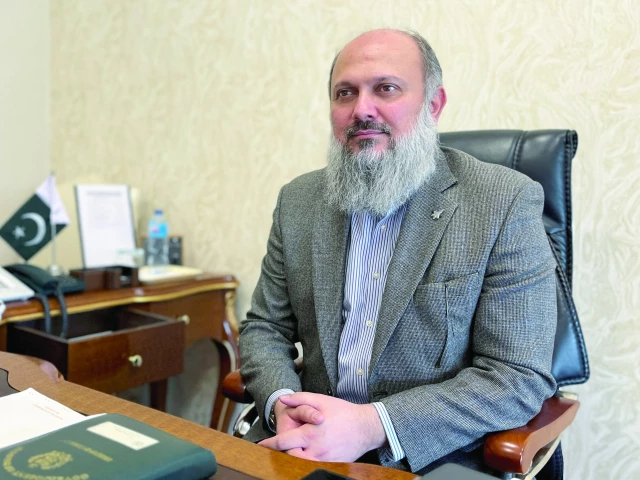Business
Levi Strauss raises prices, helping to boost profit and outlook

Levi Strauss‘s profits are growing more than Wall Street expected despite higher costs from tariffs, thanks to targeted price increases and a shift away from wholesalers, the company said Thursday as it reported fiscal third quarter results.
During the quarter, Levi’s gross margin grew 1.1 percentage points to 61.7%, up from 60.6% in the year-ago period and better than the 60.7% analysts had expected, according to StreetAccount.
In an interview with CNBC, CEO Michelle Gass said the company has started to raise the price of some of its jeans and clothes and will hike more prices in the U.S. and other markets next year.
“As we’ve been taking these targeted actions, we’ve not seen an impact to demand. We’ll of course, stay very, very close to that but … we’re taking a surgical, thoughtful approach on any pricing,” said Gass. “We know that we’re a brand that is known for great quality and value. We don’t take that for granted. We know we have to earn that every day.”
Finance chief Harmit Singh added demand is “really strong” and most of the company’s revenue growth is not coming from price increases.
Price hikes are helping Levi’s margins, but the company is also discounting less and selling more through its own website and stores instead of wholesalers, which comes at a higher margin.
The denim maker said its strong results led it to raise its full-year outlook, but added it’s still taking a “prudent” and “conservative” look at the rest of the year as it navigates ongoing macroeconomic volatility, Singh said.
Here’s how Levi’s performed during the quarter compared with what Wall Street was anticipating, based on a survey of analysts by LSEG:
- Earnings per share: 34 cents adjusted vs. 31 cents expected
- Revenue: $1.54 billion vs. $1.50 billion expected
Though Levi’s posted better-than-expected results, shares dropped more than 6% in extended trading. Its stock had climbed about 42% this year through Thursday’s close.
The company’s reported net income for the three-month period that ended Aug. 31 was $218 million, or 55 cents per share, compared with $20.7 million, or 5 cents per share, a year earlier. Excluding one-time items related to impairment and restructuring charges, among other expenses, Levi posted adjusted earnings of 34 cents per share.
Sales rose to $1.54 billion, up 7% from $1.44 billion a year earlier.
Levi’s is now expecting its full year sales to rise 3%, up from its prior guidance of between 1% and 2% growth, far exceeding expectations of a 2.9% decline, according to LSEG.
It’s expecting its full year adjusted earnings per share to be between $1.27 and $1.32, up from a prior range of between $1.25 and $1.30. At the high end, the outlook is in line with Wall Street estimates of $1.31 per share, according to LSEG.
The jeans company said it’s expecting its operating margin to be between 11.4% and 11.6%, which is also in line with expectations of 11.6%, according to StreetAccount. It’s now expecting its gross margin to rise by 1 percentage point, which is the outlook Levi’s delivered earlier this year before it factored tariffs into its forecast. At the time, its guidance didn’t reflect any tariff impact. The following quarter, it cut its gross margin guidance by 0.2 percentage points because of the new duties.
Now, Levi’s is returning to that original outlook, as long as U.S. tariffs on imports from China remain at 30% and rest-of-world duties stay at 20% for the remainder of the year.
Under the direction of Gass, Levi’s has been working to grow its direct sales, expand beyond jeans and win over more female shoppers – strategies that helped the business grow both its top and bottom lines.
During the quarter, direct-to-consumer revenue, or sales from Levi’s website and stores, grew 11%, driven by strength in the U.S. market, while women’s was up 9%. Levi’s is benefiting from strong momentum in the denim category, but the company is growing its assortment outside of just jeans, which gives it a hedge if fashion trends change.
Other types of clothes beyond denim bottoms, including tops, now make up nearly 40% of the business. The company’s efforts to sell more tops is also resonating with consumers, as that category was up 9% during the quarter.
Business
Stock Market Live Updates: Sensex, Nifty Hit Record Highs; Bank Nifty Climbs 60,000 For The First Time

Stock Market News Live Updates: Indian equity benchmarks opened with a strong gap-up on Monday, December 1, touching fresh record highs, buoyed by a sharp acceleration in Q2FY26 GDP growth to a six-quarter peak of 8.2%. Positive cues from Asian markets further lifted investor sentiment.
The BSE Sensex was trading at 85,994, up 288 points or 0.34%, after touching an all-time high of 86,159 in early deals. The Nifty 50 stood at 26,290, higher by 87 points or 0.33%, after scaling a record intraday high of 26,325.8.
Broader markets also saw gains, with the Midcap index rising 0.27% and the Smallcap index advancing 0.52%.
On the sectoral front, the Nifty Bank hit a historic milestone by crossing the 60,000 mark for the first time, gaining 0.4% to touch a fresh peak of 60,114.05.
Meanwhile, the Metal and PSU Bank indices climbed 0.8% each in early trade.
Global cues
Asia-Pacific markets were mostly lower on Monday as traders assessed fresh Chinese manufacturing data and increasingly priced in the likelihood of a US Federal Reserve rate cut later this month.
According to the CME FedWatch Tool, markets are now assigning an 87.4 per cent probability to a rate cut at the Fed’s December 10 meeting.
China’s factory activity unexpectedly slipped back into contraction in November, with the RatingDog China General Manufacturing PMI by S&P Global easing to 49.9, below expectations of 50.5, as weak domestic demand persisted.
Japan’s Nikkei 225 slipped 1.6 per cent, while the broader Topix declined 0.86 per cent. In South Korea, the Kospi dropped 0.30 per cent and Australia’s S&P/ASX 200 was down 0.31 per cent.
US stock futures were steady in early Asian trade after a positive week on Wall Street. On Friday, in a shortened post-Thanksgiving session, the Nasdaq Composite climbed 0.65 per cent to 23,365.69, its fifth consecutive day of gains.
The S&P 500 rose 0.54 per cent to 6,849.09, while the Dow Jones Industrial Average added 289.30 points, or 0.61 per cent, to close at 47,716.42.
Business
South Korea: Online retail giant Coupang hit by massive data leak

Osmond ChiaBusiness reporter
 Getty Images
Getty ImagesSouth Korea’s largest online retailer, Coupang, has apologised for a massive data breach potentially involving nearly 34 million local customer accounts.
The country’s internet authority said that it is investigating the breach and that details from the millions of accounts have likely been exposed.
Coupang is often described as South Korea’s equivalent of Amazon.com. The breach marks the latest in a series of data leaks at major firms in the country, including its telecommunications giant, SK Telecom.
Coupang told the BBC it became aware of the unauthorised access of personal data of about 4,500 customer accounts on 18 November and immediately reported it to the authorities.
But later checks found that some 33.7 million customer accounts – all in South Korea – were likely exposed, said Coupang, adding that the breach is believed to have begun as early as June through a server based overseas.
The exposed data is limited to name, email address, phone number, shipping address and some order histories, Coupang said.
No credit card information or login credentials were leaked. Those details remain securely protected and no action is required from Coupang users at this point, the firm added.
The number of accounts affected by the incident represents more than half of South Korea’s roughly-52 million population.
Coupang, which is founded in South Korea and headquartered in the US, said recently that it had nearly 25 million active users.
Coupang apologised to its customers and warned them to stay alert to scams impersonating the company.
The firm did not give details on who is behind the breach.
South Korean media outlets reported on Sunday that a former Coupang employee from China was suspected of being behind the breach.
The authorities are assessing the scale of the breach as well as whether Coupang had broken any data protection safety rules, South Korea’s Ministry of Science and ICT said in a statement.
“As the breach involves the contact details and addresses of a large number of citizens, the Commission plans to conduct a swift investigation and impose strict sanctions if it finds a violation of the duty to implement safety measures under the Protection Act.”
The incident marks the latest in a series of breaches affecting major South Korean companies this year, despite the country’s reputation for stringent data privacy rules.
SK Telecom, South Korea’s largest mobile operator, was fined nearly $100m (£76m) over a data breach involving more than 20 million subscribers.
In September, Lotte Cards also said the data of nearly three million customers was leaked after a cyber-attack on the credit card firm.
Business
Agency workers covering for Birmingham bin strikers to join picket lines

Agency workers hired to cover Birmingham bin strikers will join them on picket lines on Monday, a union has said.
A rally will be held by Unite The Union at Smithfield Depot on Pershore Street, Birmingham, on Monday morning to mark the first day of strike action by agency refuse workers.
Unite said the Job & Talent agency workers had voted in favour of strike action “over bullying, harassment and the threat of blacklisting at the council’s refuse department two weeks ago”.
The union said the number of agency workers who will join the strike action is “growing daily”.
Strikes by directly-employed bin workers, which have been running since January, could continue beyond May’s local elections.
The directly-employed bin workers voted in favour of extending their industrial action mandate earlier this month.
Unite general secretary Sharon Graham said: “Birmingham council will only resolve this dispute when it stops the appalling treatment of its workforce.
“Agency workers have now joined with directly-employed staff to stand up against the massive injustices done to them.
“Instead of wasting millions more of council taxpayers’ money fighting a dispute it could settle justly for a fraction of the cost, the council needs to return to talks with Unite and put forward a fair deal for all bin workers.
“Strikes will not end until it does.”
-

 Sports1 week ago
Sports1 week agoWATCH: Ronaldo scores spectacular bicycle kick
-

 Entertainment1 week ago
Entertainment1 week agoWelcome to Derry’ episode 5 delivers shocking twist
-

 Politics1 week ago
Politics1 week agoWashington and Kyiv Stress Any Peace Deal Must Fully Respect Ukraine’s Sovereignty
-

 Business1 week ago
Business1 week agoKey economic data and trends that will shape Rachel Reeves’ Budget
-

 Tech6 days ago
Tech6 days agoWake Up—the Best Black Friday Mattress Sales Are Here
-

 Fashion7 days ago
Fashion7 days agoCanada’s Lululemon unveils team Canada kit for Milano Cortina 2026
-

 Politics1 week ago
Politics1 week ago53,000 Sikhs vote in Ottawa Khalistan Referendum amid Carney-Modi trade talks scrutiny
-

 Tech6 days ago
Tech6 days agoThe Alienware Aurora Gaming Desktop Punches Above Its Weight


1729471601-0/image-(8)1729471601-0-640x480.webp)








